
Illustrative Math Alignment: Grade 8 Unit 2
Dilations, Similarity, and Introducing Slope
Lesson 8: Similar Triangles
Use the following Media4Math resources with this Illustrative Math lesson.
| Thumbnail Image | Title | Body | Curriculum Topic |
|---|---|---|---|
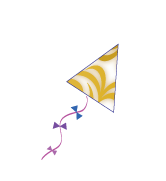
|
Math Clip Art--Geometry Concepts--Kite Shape 13 | Math Clip Art--Kite Shape 13TopicGeometry Concepts DescriptionThis image illustrates a triangular-shaped kite. Geometrically, a kite is a quadrilateral with two pairs of adjacent equal-length sides and diagonals that intersect at right angles. The symmetry and unique properties of kite shapes make them interesting geometric figures. Kite shapes are used to explore properties such as symmetry, area, and perimeter. They are applicable in various mathematical contexts, including geometry and design. Teacher's Script: "Observe this kite. How is this a kite in the everyday sense? Is this a kite in the geometric sense?" |
Definition of a Polygon and Definition of a Triangle |
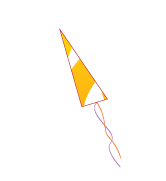
|
Math Clip Art--Geometry Concepts--Kite Shape 14 | Math Clip Art--Kite Shape 14TopicGeometry Concepts DescriptionThis image features a triangular-shaped kite. Geometrically, a kite is a quadrilateral with two pairs of adjacent equal-length sides and diagonals that intersect at right angles. The symmetry and unique properties of kite shapes make them interesting geometric figures. Kite shapes are used to explore properties such as symmetry, area, and perimeter. They are applicable in various mathematical contexts, including geometry and design. Teacher's Script: "Examine this kite. How is it a kite in the everyday sense? Is it geometrically a kite?" |
Definition of a Polygon and Definition of a Triangle |
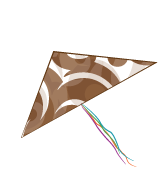
|
Math Clip Art--Geometry Concepts--Kite Shape 15 | Math Clip Art--Kite Shape 15TopicGeometry Concepts DescriptionThis image depicts a triangular-shaped kite. Geometrically, a kite is characterized by two pairs of adjacent equal-length sides and diagonals that intersect at right angles. This geometric configuration is symmetrical and unique. Kite shapes are used to explore geometric properties such as symmetry, area, and perimeter. They are applicable in various fields, including mathematics, design, and architecture. Teacher's Script: "Look at this kite. How is this a kite in the everyday sense? Is this a kite in the geometric sense?" |
Definition of a Polygon and Definition of a Triangle |
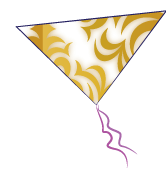
|
Math Clip Art--Geometry Concepts--Kite Shape 16 | Math Clip Art--Kite Shape 16TopicGeometry Concepts DescriptionThis image illustrates a triangular-shaped kite. Geometrically, a kite is a quadrilateral with two pairs of adjacent equal-length sides and diagonals that intersect at right angles. The symmetry and unique properties of kite shapes make them interesting geometric figures. Kite shapes are used to explore properties such as symmetry, area, and perimeter. They are applicable in various mathematical contexts, including geometry and design. Teacher's Script: "Observe this kite. How is this a kite in the everyday sense? Is this a kite in the geometric sense?" |
Definition of a Polygon and Definition of a Triangle |

|
Math Clip Art--Geometry Concepts--Kite Shape 2 | Math Clip Art--Kite Shape 2TopicGeometry Concepts DescriptionThis image depicts another variation of a kite shape, in this case a circular shape. Geometrically, a kite is characterized by two pairs of adjacent equal-length sides and diagonals that intersect at right angles. This geometric configuration is symmetrical and unique. Kite shapes are used to explore geometric properties such as symmetry, area, and perimeter. They are applicable in various fields, including mathematics, design, and architecture. Teacher's Script: "Look at this kite. How is it a kite in the everyday sense? Is it a kite in a geometric sense?" |
Definition of a Circle, Definition of a Polygon and Definition of a Triangle |

|
Math Clip Art--Geometry Concepts--Kite Shape 3 | Math Clip Art--Kite Shape 3TopicGeometry Concepts DescriptionThis image illustrates a circular kite shape. Geometrically, a kite is a a quadrilateral with two pairs of adjacent equal-length sides and diagonals that intersect at right angles. The symmetry and unique properties of kite shapes make them interesting geometric figures. Kite shapes are used to explore properties such as symmetry, area, and perimeter. They are applicable in various mathematical contexts, including geometry and design. Teacher's Script: "Observe this kite. How is a kite in the everyday sense of the word? Is it a kite in the geometric sense?" |
Definition of a Circle, Definition of a Polygon and Definition of a Triangle |
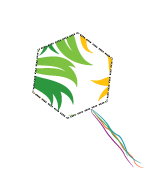
|
Math Clip Art--Geometry Concepts--Kite Shape 4 | Math Clip Art--Kite Shape 4TopicGeometry Concepts DescriptionThis image features a hexagonal kite shape. Geometrically, a kite is a quadrilateral with two pairs of adjacent equal-length sides and diagonals that intersect at right angles. The symmetry and unique properties of kite shapes make them interesting geometric figures. Kite shapes are used to explore properties such as symmetry, area, and perimeter. They are applicable in various mathematical contexts, including geometry and design. Teacher's Script: "Examine this kite. How is it a kite in the everyday sense? Is it a kite in a geometric sense?" |
Definition of a Polygon and Definition of a Triangle |
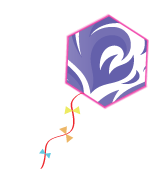
|
Math Clip Art--Geometry Concepts--Kite Shape 5 | Math Clip Art--Kite Shape 5TopicGeometry Concepts DescriptionThis image depicts a hexagonal kite shape. Geometrically, a kite is characterized by two pairs of adjacent equal-length sides and diagonals that intersect at right angles. This geometric configuration is symmetrical and unique. Kite shapes are used to explore geometric properties such as symmetry, area, and perimeter. They are applicable in various fields, including mathematics, design, and architecture. Teacher's Script: "Look at this kite. How is this a kite in the everydays sense of the word? Is it a kite in the geometric sense?" |
Definition of a Polygon and Definition of a Triangle |

|
Math Clip Art--Geometry Concepts--Kite Shape 6 | Math Clip Art--Kite Shape 6TopicGeometry Concepts DescriptionThis image illustrates a hexagonal kite shape. Geometrically, a kite is a quadrilateral with two pairs of adjacent equal-length sides and diagonals that intersect at right angles. The symmetry and unique properties of kite shapes make them interesting geometric figures. Kite shapes are used to explore properties such as symmetry, area, and perimeter. They are applicable in various mathematical contexts, including geometry and design. Teacher's Script: "Observe this kite. How is it a kite in the everyday sense? Is it a kite in the geometric sense?" |
Definition of a Polygon and Definition of a Triangle |
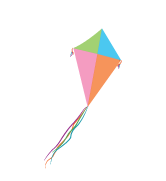
|
Math Clip Art--Geometry Concepts--Kite Shape 7 | Math Clip Art--Kite Shape 7TopicGeometry Concepts DescriptionThis image features a kite shape, a quadrilateral with two pairs of adjacent equal-length sides and diagonals that intersect at right angles. The symmetry and unique properties of kite shapes make them interesting geometric figures. Kite shapes are used to explore properties such as symmetry, area, and perimeter. They are applicable in various mathematical contexts, including geometry and design. |
Definition of a Polygon and Definition of a Triangle |
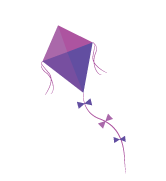
|
Math Clip Art--Geometry Concepts--Kite Shape 8 | Math Clip Art--Kite Shape 8TopicGeometry Concepts DescriptionThis image depicts a kite shape, characterized by two pairs of adjacent equal-length sides and diagonals that intersect at right angles. This geometric configuration is symmetrical and unique. Kite shapes are used to explore geometric properties such as symmetry, area, and perimeter. They are applicable in various fields, including mathematics, design, and architecture. Teacher's Script: "Look at this kite shape. How do its symmetrical properties and intersecting diagonals help us understand its geometry? What are some mathematical concepts you can explore using kite shapes?" |
Definition of a Polygon and Definition of a Triangle |

|
Math Clip Art--Geometry Concepts--Kite Shape 9 | Math Clip Art--Kite Shape 9TopicGeometry Concepts DescriptionThis image illustrates a kite shape, a quadrilateral with two pairs of adjacent equal-length sides and diagonals that intersect at right angles. The symmetry and unique properties of kite shapes make them interesting geometric figures. Kite shapes are used to explore properties such as symmetry, area, and perimeter. They are applicable in various mathematical contexts, including geometry and design. |
Definition of a Polygon and Definition of a Triangle |
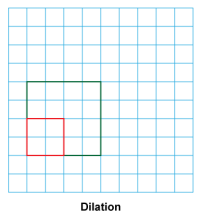
|
Math Clip Art--Geometry Concepts--Similarity with Transformations--01 | Math Clip Art--Similarity with Transformations--01TopicGeometry Concepts DescriptionThis image depicts a square undergoing a dilation transformation. Dilation changes the size of a figure while maintaining its shape, resulting in a similar figure. The scale factor of the dilation determines whether the square is enlarged or reduced. In this transformation, all sides of the square are scaled by the same factor, and all angles remain congruent to the original. This preserves the square's shape while changing its size, demonstrating the concept of similarity in geometry. |
Proportions |

|
Math Clip Art--Geometry Concepts--Similarity with Transformations--02 | Math Clip Art--Similarity with Transformations--02TopicGeometry Concepts DescriptionThis image shows a square undergoing a combination of dilation and translation. The dilation changes the size of the square while maintaining its shape, and the translation moves the dilated square to a new position without changing its size or orientation. This composite transformation demonstrates how multiple transformations can be applied sequentially. The resulting figure is similar to the original square but different in size and position. |
Proportions |
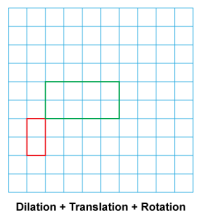
|
Math Clip Art--Geometry Concepts--Similarity with Transformations--03 | Math Clip Art--Similarity with Transformations--03TopicGeometry Concepts DescriptionThis image illustrates a rectangle undergoing a combination of dilation, translation, and rotation. The dilation changes the size of the rectangle, the translation moves it to a new position, and the rotation changes its orientation. This complex transformation demonstrates how multiple transformations can be combined to create a figure that is similar to the original but different in size, position, and orientation. The resulting figure maintains the proportions of the original rectangle. |
Proportions |
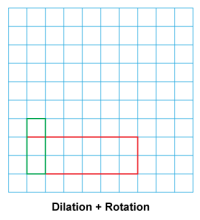
|
Math Clip Art--Geometry Concepts--Similarity with Transformations--04 | Math Clip Art--Similarity with Transformations--04TopicGeometry Concepts DescriptionThis image shows a rectangle undergoing a combination of dilation and rotation. The dilation changes the size of the rectangle while maintaining its proportions, and the rotation changes its orientation. This transformation demonstrates how a figure can be both resized and reoriented while maintaining its shape. The resulting figure is similar to the original rectangle but different in size and orientation. |
Proportions |
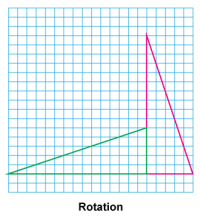
|
Math Clip Art--Geometry Concepts--Similarity with Transformations--05 | Math Clip Art--Similarity with Transformations--05TopicGeometry Concepts DescriptionThis image depicts a triangle undergoing a rotation transformation. The rotation changes the orientation of the triangle without altering its size or shape. This transformation demonstrates how a figure can be moved around a fixed point (the center of rotation) while maintaining its congruence to the original shape. The resulting triangle is identical to the original in all aspects except its orientation. |
Proportions |

|
Math Clip Art--Geometry Concepts--Similarity with Transformations--06 | Math Clip Art--Similarity with Transformations--06TopicGeometry Concepts DescriptionThis image shows a triangle undergoing a translation transformation. The translation moves the triangle to a new position without changing its size, shape, or orientation. This transformation demonstrates how a figure can be moved in a straight line without any other changes. The resulting triangle is congruent to the original and maintains all its properties, only differing in its position. |
Proportions |
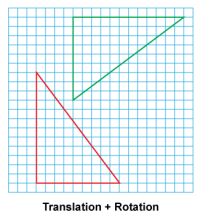
|
Math Clip Art--Geometry Concepts--Similarity with Transformations--07 | Math Clip Art--Similarity with Transformations--07TopicGeometry Concepts DescriptionThis image illustrates a triangle undergoing a combination of translation and rotation. The translation moves the triangle to a new position, and the rotation changes its orientation. This composite transformation demonstrates how multiple transformations can be applied sequentially. The resulting triangle is congruent to the original but different in both position and orientation. |
Proportions |
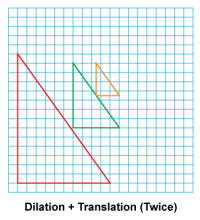
|
Math Clip Art--Geometry Concepts--Similarity with Transformations--08 | Math Clip Art--Similarity with Transformations--08TopicGeometry Concepts DescriptionThis image shows a triangle undergoing a combination of dilation and translation performed twice. The dilation changes the size of the triangle while maintaining its shape, and the translations move it to new positions. This complex transformation demonstrates how multiple transformations can be applied repeatedly. The resulting triangles are similar to the original but differ in size and position. |
Proportions |
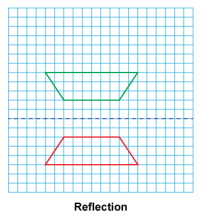
|
Math Clip Art--Geometry Concepts--Similarity with Transformations--09 | Math Clip Art--Similarity with Transformations--09TopicGeometry Concepts DescriptionThis image depicts a trapezoid reflected across a horizontal line. Reflection creates a mirror image of the original figure across a line of reflection. This transformation demonstrates how a figure can be flipped over a line to create its mirror image. The resulting trapezoid is congruent to the original but inverted vertically. Teacher's Script: "Observe how the trapezoid is reflected across the horizontal line. What properties of the trapezoid remain unchanged? How does the orientation of the trapezoid change after reflection? Can you identify the line of reflection?" |
Proportions |
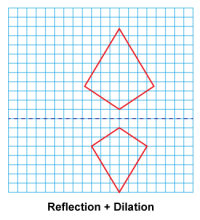
|
Math Clip Art--Geometry Concepts--Similarity with Transformations--10 | Math Clip Art--Similarity with Transformations--10TopicGeometry Concepts DescriptionThis image shows a kite reflected across a horizontal line, followed by a dilation. Reflection creates a mirror image of the original figure across a line of reflection. Dilation changes the size of the original figure but keeps it proportional. This transformation demonstrates how a figure can be flipped over a line to create its mirror image. The resulting kite is similar to the original but inverted vertically. |
Proportions |
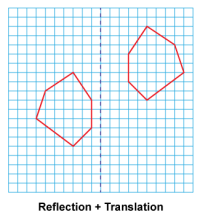
|
Math Clip Art--Geometry Concepts--Similarity with Transformations--11 | Math Clip Art--Similarity with Transformations--11TopicGeometry Concepts DescriptionThis image illustrates an irregular hexagon reflected across a vertical line. Reflection creates a mirror image of the original figure across a line of reflection. This transformation demonstrates how a complex figure can be flipped over a vertical line to create its mirror image. The resulting hexagon is congruent to the original but reversed horizontally. |
Proportions |
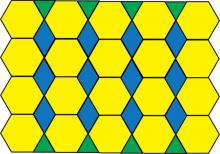
|
Math Clip Art--Geometry Concepts--Tessellation Pattern 1 | Math Clip Art--Tessellation Pattern 1TopicGeometry Concepts DescriptionThis image shows a tessellation pattern formed using basic shapes from pattern blocks. Pattern blocks typically include shapes such as equilateral triangles (green), squares (orange), rhombuses (blue), trapezoids (red), hexagons (yellow), and parallelograms (tan). These shapes fit together without gaps or overlaps to create a continuous pattern. Pattern block tessellations are excellent for exploring geometric concepts such as symmetry, transformations, and spatial reasoning. They provide a hands-on way to understand how shapes can be combined to cover a plane completely. |
Geometric Constructions with Polygons |
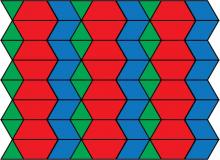
|
Math Clip Art--Geometry Concepts--Tessellation Pattern 2 | Math Clip Art--Tessellation Pattern 2TopicGeometry Concepts DescriptionThis image presents another tessellation pattern using basic shapes from pattern blocks. The basic pattern block shapes include equilateral triangles, squares, rhombuses, trapezoids, hexagons, and parallelograms. They are arranged to cover a plane without gaps or overlaps, demonstrating the principles of tessellation. Tessellations with pattern blocks help students explore geometric concepts such as symmetry, transformations, and tiling. They provide a visual and interactive way to understand how shapes can be combined to create complex patterns. |
Geometric Constructions with Polygons |

|
Math Clip Art--Geometry Concepts--Tessellation Pattern 3 | Math Clip Art--Tessellation Pattern 3TopicGeometry Concepts DescriptionThis image displays a tessellation pattern created with basic shapes from pattern blocks. The basic pattern block set includes equilateral triangles, squares, rhombuses, trapezoids, hexagons, and parallelograms. These shapes are arranged to tile a plane without gaps or overlaps. Using pattern blocks for tessellations allows students to explore geometric concepts such as symmetry, transformations, and spatial reasoning. They provide a hands-on approach to understanding how different shapes can be combined to form intricate patterns. |
Geometric Constructions with Polygons |
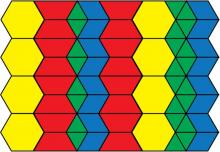
|
Math Clip Art--Geometry Concepts--Tessellation Pattern 4 | Math Clip Art--Tessellation Pattern 4TopicGeometry Concepts DescriptionThis image presents a tessellation pattern using basic shapes from pattern blocks. A basic pattern block set includes equilateral triangles, squares, rhombuses, trapezoids, hexagons, and parallelograms. These shapes are arranged to cover a plane without gaps or overlaps, illustrating the concept of tessellation. Tessellations with pattern blocks help students explore geometric concepts like symmetry, transformations, and tiling. They provide a visual and interactive way to understand how shapes can be combined to create complex patterns. |
Geometric Constructions with Polygons |
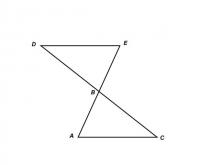
|
Math Clip Art--Triangles--Two Triangles Share Vertical Angles Congruent--Labeled | Math Clip Art--Triangles--Two Triangles Share Vertical Angles Congruent--Labeled
This is from a collection of triangular shapes. They come labeled and unlabeled. |
Applications of Triangles |
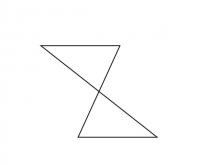
|
Math Clip Art--Triangles--Two Triangles Share Vertical Angles Congruent--Unlabeled | Math Clip Art--Triangles--Two Triangles Share Vertical Angles Congruent--Unlabeled
This is from a collection of triangular shapes. They come labeled and unlabeled. |
Applications of Triangles |
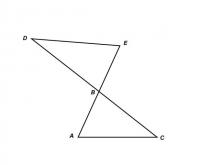
|
Math Clip Art--Triangles--Two Triangles Share Vertical Angles Non Congruent--Labeled | Math Clip Art--Triangles--Two Triangles Share Vertical Angles Non Congruent--Labeled
This is from a collection of triangular shapes. They come labeled and unlabeled. |
Applications of Triangles |
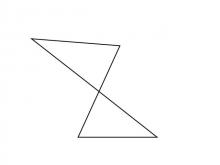
|
Math Clip Art--Triangles--Two Triangles Share Vertical Angles Non Congruent--Unlabeled | Math Clip Art--Triangles--Two Triangles Share Vertical Angles Non Congruent--Unlabeled
This is from a collection of triangular shapes. They come labeled and unlabeled. |
Applications of Triangles |
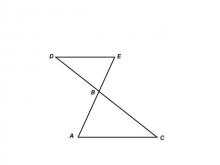
|
Math Clip Art--Triangles--Two Triangles Share Vertical Angles Similar--Labeled | Math Clip Art--Triangles--Two Triangles Share Vertical Angles Similar--Labeled
This is from a collection of triangular shapes. They come labeled and unlabeled. |
Applications of Triangles |
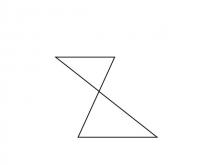
|
Math Clip Art--Triangles--Two Triangles Share Vertical Angles Similar--Unlabeled | Math Clip Art--Triangles--Two Triangles Share Vertical Angles Similar--Unlabeled
This is from a collection of triangular shapes. They come labeled and unlabeled. |
Applications of Triangles |
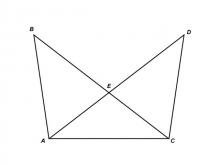
|
Math Clip Art--Triangles--Two Triangles with Common Base--Congruent--Labeled | Math Clip Art--Triangles--Two Triangles with Common Base--Congruent--Labeled
This is from a collection of triangular shapes. They come labeled and unlabeled. |
Applications of Triangles |
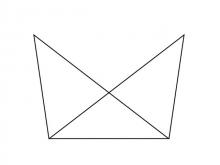
|
Math Clip Art--Triangles--Two Triangles with Common Base--Congruent--Unlabeled | Math Clip Art--Triangles--Two Triangles with Common Base--Congruent--Unlabeled
This is from a collection of triangular shapes. They come labeled and unlabeled. |
Applications of Triangles |
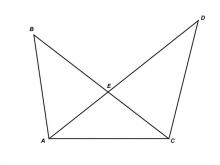
|
Math Clip Art--Triangles--Two Triangles with Common Base--Non Congruent--Labeled | Math Clip Art--Triangles--Two Triangles with Common Base--Non Congruent--Labeled
This is from a collection of triangular shapes. They come labeled and unlabeled. |
Applications of Triangles |
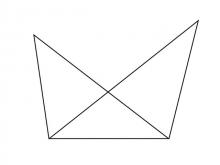
|
Math Clip Art--Triangles--Two Triangles with Common Base--Non Congruent--Unlabeled | Math Clip Art--Triangles--Two Triangles with Common Base--Non Congruent--Unlabeled
This is from a collection of triangular shapes. They come labeled and unlabeled. |
Applications of Triangles |

|
Math Clip Art: Comparing Right Triangles | Math Clip Art: Comparing Right Triangles Use these clip art images and the background grid to test if the right triangles are similar. |
Right Triangles |
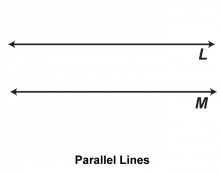
|
Math Clip Art: Parallel Lines Cut by a Transversal 1 | Math Clip Art: Parallel Lines Cut by a Transversal 1TopicGeometry DescriptionThis math clip art image is part of a series that illustrates the properties of parallel lines cut by a transversal. In this particular image, we see two parallel lines without a transversal, serving as an introduction to the concept. The image is designed to help students visualize and understand the fundamental idea of parallel lines before exploring more complex relationships. |
Parallel Lines |
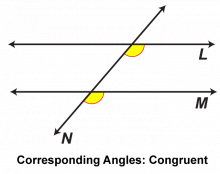
|
Math Clip Art: Parallel Lines Cut by a Transversal 10 | Math Clip Art: Parallel Lines Cut by a Transversal 10TopicGeometry DescriptionThis math clip art image is part of a series illustrating the properties of parallel lines cut by a transversal. It showcases a fourth pair of corresponding angles, solidifying the concept that these angles are congruent when parallel lines are cut by a transversal. The image uses a distinct color coding to identify this final pair of corresponding angles, providing students with a comprehensive view of all possible corresponding angle pairs in this configuration. |
Parallel Lines |
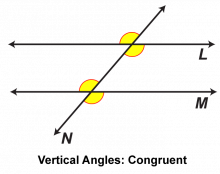
|
Math Clip Art: Parallel Lines Cut by a Transversal 11 | Math Clip Art: Parallel Lines Cut by a Transversal 11TopicGeometry DescriptionThis math clip art image is part of a series illustrating the properties of parallel lines cut by a transversal. It highlights vertical angles, demonstrating that these angles are congruent when any two lines intersect. The image uses color coding to clearly identify a pair of vertical angles, making it easier for students to visualize and understand this geometric relationship. |
Parallel Lines |
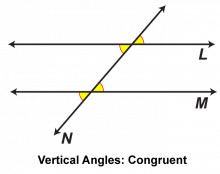
|
Math Clip Art: Parallel Lines Cut by a Transversal 12 | Math Clip Art: Parallel Lines Cut by a Transversal 12TopicGeometry DescriptionThis math clip art image is part of a series illustrating the properties of parallel lines cut by a transversal. It focuses on another pair of vertical angles, reinforcing the concept that these angles are congruent when any two lines intersect. The image uses distinct color coding to identify this second pair of vertical angles, providing students with a clear visual representation of this geometric relationship. |
Parallel Lines |
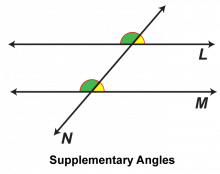
|
Math Clip Art: Parallel Lines Cut by a Transversal 13 | Math Clip Art: Parallel Lines Cut by a Transversal 13TopicGeometry DescriptionThis math clip art image is part of a series illustrating the properties of parallel lines cut by a transversal. It highlights supplementary angles, demonstrating that certain pairs of angles formed by parallel lines and a transversal are supplementary (their measures add up to 180°). The image uses color coding to clearly identify a pair of supplementary angles, making it easier for students to visualize and understand this geometric relationship. |
Parallel Lines |
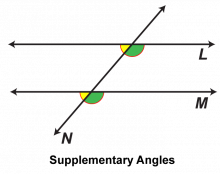
|
Math Clip Art: Parallel Lines Cut by a Transversal 14 | Math Clip Art: Parallel Lines Cut by a Transversal 14TopicGeometry DescriptionThis math clip art image is part of a series illustrating the properties of parallel lines cut by a transversal. It focuses on another pair of supplementary angles, reinforcing the concept that certain pairs of angles formed by parallel lines and a transversal are supplementary. The image uses distinct color coding to identify this second pair of supplementary angles, providing students with a clear visual representation of this geometric relationship. |
Parallel Lines |
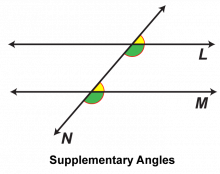
|
Math Clip Art: Parallel Lines Cut by a Transversal 15 | Math Clip Art: Parallel Lines Cut by a Transversal 15TopicGeometry DescriptionThis math clip art image is part of a series illustrating the properties of parallel lines cut by a transversal. It showcases a third pair of supplementary angles, solidifying the concept that certain pairs of angles formed by parallel lines and a transversal are supplementary. The image uses a unique color coding to identify this pair of supplementary angles, providing students with multiple examples of this geometric relationship. |
Parallel Lines |

|
Math Clip Art: Parallel Lines Cut by a Transversal 16 | Math Clip Art: Parallel Lines Cut by a Transversal 16TopicGeometry DescriptionThis math clip art image is part of a series illustrating the properties of parallel lines cut by a transversal. It showcases a fourth pair of supplementary angles, reinforcing the concept that certain pairs of angles formed by parallel lines and a transversal are supplementary (their measures add up to 180°). The image uses distinct color coding to identify this pair of supplementary angles, providing students with a comprehensive view of all possible supplementary angle pairs in this configuration. |
Parallel Lines |
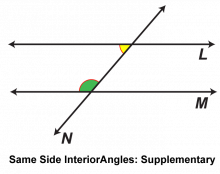
|
Math Clip Art: Parallel Lines Cut by a Transversal 17 | Math Clip Art: Parallel Lines Cut by a Transversal 17TopicGeometry DescriptionThis math clip art image is part of a series illustrating the properties of parallel lines cut by a transversal. It highlights same side interior angles, demonstrating that these angles are supplementary (their measures add up to 180°) when parallel lines are cut by a transversal. The image uses color coding to clearly identify a pair of same side interior angles, making it easier for students to visualize and understand this geometric relationship. |
Parallel Lines |
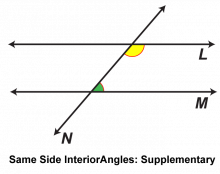
|
Math Clip Art: Parallel Lines Cut by a Transversal 18 | Math Clip Art: Parallel Lines Cut by a Transversal 18TopicGeometry DescriptionThis math clip art image is part of a series illustrating the properties of parallel lines cut by a transversal. It focuses on another pair of same side interior angles, reinforcing the concept that these angles are supplementary when parallel lines are cut by a transversal. The image uses distinct color coding to identify this second pair of same side interior angles, providing students with a clear visual representation of this geometric relationship. |
Parallel Lines |
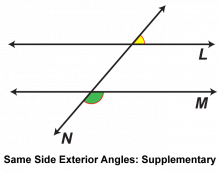
|
Math Clip Art: Parallel Lines Cut by a Transversal 19 | Math Clip Art: Parallel Lines Cut by a Transversal 19TopicGeometry DescriptionThis math clip art image is part of a series illustrating the properties of parallel lines cut by a transversal. It highlights same side exterior angles, demonstrating that these angles are supplementary (their measures add up to 180°) when parallel lines are cut by a transversal. The image uses color coding to clearly identify a pair of same side exterior angles, making it easier for students to visualize and understand this geometric relationship. |
Parallel Lines |

|
Math Clip Art: Parallel Lines Cut by a Transversal 2 | Math Clip Art: Parallel Lines Cut by a Transversal 2TopicGeometry DescriptionThis math clip art image is the second in a series illustrating the properties of parallel lines cut by a transversal. It shows two parallel lines intersected by a third line, known as a transversal. This visual representation is crucial for introducing students to the concept of parallel lines cut by a transversal and the various angle relationships that result from this configuration. |
Parallel Lines |